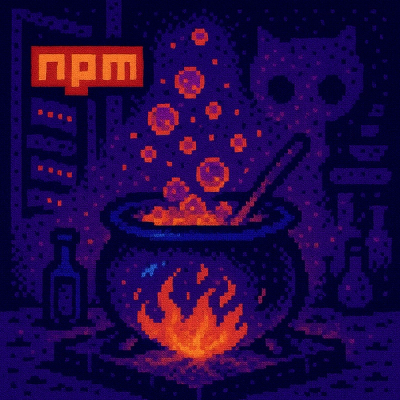
Security News
The Changelog Podcast: Practical Steps to Stay Safe on npm
Learn the essential steps every developer should take to stay secure on npm and reduce exposure to supply chain attacks.
Migration Bundler is a database schema management system written in Ruby. It currently supports SQLite and Cassandra database targets. It was built to solve the schema management challenges on the mobile SDK's and server side services developed for the Layer platform.
Migration Bundler manages a Git repository containing a database schema and an arbitrary number of migrations. The migrations are authored in SQL format and platform specific renderings of the schema and migrations are created via code generation. The current schema and all associated migrations can then be packaged into a release and shipped as a versioned, installable package.
Migration Bundler requires a modern Ruby runtime (v1.9.x and up) and the following supporting cast:
Migration Bundler is a commandline utility available via the mb binary. There are a number of standard commandline
switches available that control the defaults and target behavior of a Migration Bundler invocation. You can obtain help directly from the
application by executing mb help.
Creates a new Migration Bundler schema repository at the path specified. Please refer to the documentation below regarding the repository structure.
$ mb init [path/to/project]
The default database target is SQLite, but you can specify an alternate database by using the database switch:
$ mb init --database=cassandra://localhost:9042/keyspace
Loads the current schema defined in schema.sql into a local database named database.sqlite.
$ mb load
Creates a new migration file at migrations/[TIMESTAMP]_[NAME].sql. Please refer to the documentation below about timestamp
and versioning semantics.
$ mb create [name]
Displays information about the current schema and any unapplied migrations.
$ mb status
Applies all pending to a target database by directly executing the SQL migrations.
$ mb migrate [target version]
Generates platform specific implementations into migrations/[migration].m and migrations/[migration].java.
$ mb generate
Validates that the schema loads and all migrations apply forward from a clean database.
$ mb validate
Packages a release of the schema by validating the project, generating all implementations, and creating a tag into the project Git repository.
$ mb package [version]
Pushes a release to Git, CocoaPods, and Maven.
$ mb push [version]
Migration Bundler was designed to deliver the following properties:
This portion of the document details how Migration Bundler has been implemented to deliver these properties.
A Migration Bundler project is a simple filesystem layout with version control provided by Git. When a new project is initialized, it has the following structure:
.
├── .gitignore
├── .migration_bundler.yml
├── [project-name].sql
├── [project-name].sqlite
└── migrations
└── <date-created>-create-[project-name].sql
Subsequent commands will create files into this filesystem and perform manipulations on the database. The schema can be branched, merged, and released using standard Git techniques.
The client schema is internally versioned using timestamps. Timestamps are used instead of monotonically incrementing integers because they better
support a branched, multi-developer workflow. The latest version of the overall schema is equal to the timestamp of the most recently applied migration.
The current schema version of a given database is derivable by examining the schema_migrations table, which maintains a record of all migrations that
have been applied to the database since its creation.
The schema_migrations table has the following schema:
CREATE TABLE schema_migrations(
version INTEGER UNIQUE NOT NULL
);
The version column encodes the date a migration was created. The presence of a given migration version in the table indicates that the migration
has been applied to the parent database.
To compute the "origin version" (the version of the schema at the time the database was created), select the minimum value for the version column in the schema_migrations table:
SELECT MIN(version) FROM schema_migrations
The current version of the database is computable by selecting the maximum value for the version column present in the schema_migrations table:
SELECT MAX(version) FROM schema_migrations
Note that knowing the current version is not sufficient for computing if the database is fully migrated. This is because migrations that were created in the past may not yet have been merged, released and applied yet.
In order to compute the set of migrations that have not yet been applied to a given database, one must take the following steps:
SELECT version FROM schema_migrations);Migrations are authored in pure SQL. A code generation process is used to platform-specific, executable implementation of the migrations in Java and Objective-C from the source SQL files.
The SQL migration files are named by concatenating a timestamp version with a brief textual description of the database change they introduce to the system.
This naming convention is of the form "${VERSION_IDENTIFIER}_${MIGRATION_DESCRIPTION_UNDERSCORED}.sql". The VERSION_IDENTIFIER is equal to the
following invocation of the date utility (on platforms with GNU coreutils): date +"%Y%m%d%H%M%S%3N" This date format includes the year, month, day, hour, minute,
second and three digits of milliseconds. This ensures that there is very little chance of overlap no matter how many developers are working on the schema,
while still supporting very straightforward sorting in the database.
An example migration file might be called: 201405125248499_add_unqiue_constraint_to_streams.sql
The implementation of the generated migration class in Objective-C may look like:
@interface MBAddUniqueConstraintToStreamsMigration : NSObject <MBMigratable>
@end
@implementation LYR_AddUniqueConstraintToStreamsMigration
+ (NSString *)version
{
return @"201405125248499";
}
- (BOOL)migrateDatabase:(FMDatabase *)database error:(out NSError *__autoreleasing *)error
{
// Apply the migration
}
@end
Platform specific migrations can also be generated.
Migration Bundler itself only generates installable packages containing the schema and migrations. To utilize these schemas in an application you'll need support code. The following companion projects are available for this use:
Blake Watters
Migration Bundler is available under the Apache 2 License. See the LICENSE file for more info.
FAQs
Unknown package
We found that migration_bundler demonstrated a not healthy version release cadence and project activity because the last version was released a year ago. It has 1 open source maintainer collaborating on the project.
Did you know?

Socket for GitHub automatically highlights issues in each pull request and monitors the health of all your open source dependencies. Discover the contents of your packages and block harmful activity before you install or update your dependencies.

Security News
Learn the essential steps every developer should take to stay secure on npm and reduce exposure to supply chain attacks.

Security News
Experts push back on new claims about AI-driven ransomware, warning that hype and sponsored research are distorting how the threat is understood.

Security News
Ruby's creator Matz assumes control of RubyGems and Bundler repositories while former maintainers agree to step back and transfer all rights to end the dispute.